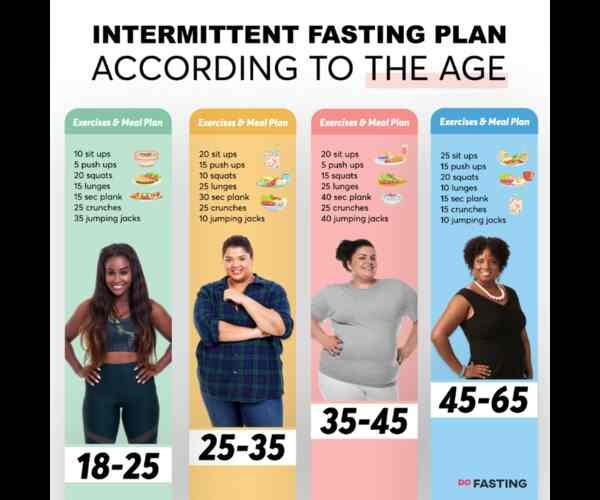
Intermittent Fasting by Age Chart and Gender – Intermittent Fasting Plan According to Age
Intermittent fasting has gained significant popularity in recent years as a powerful tool for weight management and overall health improvement. But have you ever wondered how this approach may differ based on age and gender?
Intermittent Fasting by Age Chart and Gender: A Comprehensive Guide
Intermittent fasting has gained immense popularity as an effective eating pattern, comparable to the ketogenic diet. With over ten million search results online, it is clear that people are increasingly intrigued by the potential health benefits associated with intermittent fasting.
Although intermittent fasting could be an excellent choice for men, it may not be the best option for women since it does not affect both genders similarly.
This article aims to delve into the fundamentals of intermittent fasting, explore its various methods and reap the full benefits of this eating pattern.
What is Intermittent Fasting
Intermittent fasting involves restricting food intake to specific periods, alternating between periods of calorie restriction or fasting and periods of regular eating.
Unlike traditional diets that focus on what you consume, intermittent fasting days emphasizes when you eat. It is essential to select the approach that aligns best with your lifestyle and consult with your doctor before embarking on any dietary changes.
Health benefits of intermittent fasting for women – What are the benefits of intermittent fasting?
- Improves Heart health
- Increased longevity
- Reduced diabetes risk
- Reduced inflammation
- Preserve muscle mass
- Improved memory
- Physical performance
- Improves Tissue health
- Help with cancer treatments
- Improved psychological well-being
- Protection from neurodegenerative illnesses
Types of Intermittent fasting By Age
There are different methods Intermittent fasting schedule by age and gender available, ranging from
- The alternate day method
- Twice-weekly method
- Time-restricted eating method
Intermittent Fasting By Age
Intermittent fasting is a dietary approach that involves cycling between periods of fasting and eating. While the concept remains the same across age groups, there are age-related considerations.
Basically, for adolescents and teenagers, intermittent fasting is generally not recommended without medical supervision. it’s important to ensure an adequate intake of essential nutrients for proper development and growth among Adolescents and Teenagers.
Young adults can engage in intermittent fasting, ensuring a balanced diet during eating windows. Middle-aged adults should pay closer attention to their nutritional needs.
Older adults can consider intermittent fasting but must be mindful of health conditions and medications. Individual variations and health considerations should always be taken into account, and consulting with a healthcare professional is advised.
Intermittent Fasting By Age Chart
| Age | Considerations | Best Possible Intermittent Fasting Plans |
| 18 to 30 | Social commitments | 16/8, 18/6 |
| 30 to 45 | Personal and professional responsibilities | 16/8, 14/10 |
| 45 to 60 | Post-menopausal weight gain | 16/8, 18/6, ADF, 5/2 |
| 60 and above | Focus on nutrition | 12/12, 14/10 |
The Benefits of Intermittent Fasting By Age – How does it work?
Apart from its potential for weight loss, intermittent fasts work has been linked to numerous health benefits.
Research suggests that intermittent fasting may reduce the risk of chronic illnesses and offer specific advantages for women’s health.
Some of the proven benefits include improved musculoskeletal and metabolic health, enhanced mental well-being, increased longevity, and reduced inflammation.
Additionally, intermittent fasting work very well in improving memory, physical performance, heart health, and protecting against neurodegenerative diseases. However, it is crucial to note that these benefits are not solely limited to weight loss but extend to overall health and well-being.
Intermittent Fasting and Age – Intermittent Fasting Plan According to Age Chart
Age plays a crucial role in how our bodies respond to different dietary and lifestyle interventions, and intermittent fasting is no exception. Here’s a breakdown of how intermittent fasting can be adjusted according to age:
Young Adults (18-30 years): Intermittent Fasting by Age Chart
Young adults generally have a higher metabolic rate and fewer age-related health concerns. They can experiment with more flexible fasting schedules, such as the 16:8 method (16 hours fasting, 8 hours eating), or even longer fasting periods.
Middle-aged Adults (31-50 years): Intermittent Fasting by Age Chart
As we enter middle age, metabolic changes and hormonal shifts start to occur. It’s important for individuals in this age group to focus on a balanced approach, such as the 14:10 method, to ensure adequate nutrition while reaping the benefits of intermittent fasting.
Older Adults (51+ years): Intermittent Fasting by Age Chart
With advancing age, nutritional needs may change, and certain health conditions may arise. Older adults are advised to consult with a healthcare professional before embarking on an intermittent fasting regimen. They might find the 12:12 method, where the fasting and eating windows are equal, more suitable and sustainable.
It’s important to remember that these age ranges are general guidelines, and individual variations and health conditions should always be taken into account.
Intermittent Fasting According to Gender
Gender can also influence how intermittent fasting is implemented. Here’s a closer look at how it can be adapted for different genders:
If you want to do intermittent fasting successfully, you need to make it a part of your regular routine. Intermittent fasting involves alternating between times of eating and fasting, and there are different ways to do it, such as twice a week, every other day, or at specific times.
However, the effects of intermittent fasting vary for men and women, and women should be especially careful about potential effects on overall health, bone health, and reproductive health.
Despite this, intermittent fasting may have some health benefits, such as weight loss, improved heart health, and a reduced risk of developing diabetes. Since everyone’s body is different, it’s important to pay attention to how your body responds to different types of meals and eating patterns.
Fasting for Men:
Men tend to have higher muscle mass and testosterone levels compared to women. As a result, they may experience more pronounced effects of intermittent fasting, such as increased muscle gain and fat loss. Men can generally follow the same fasting protocols as young or middle-aged adults, depending on their specific goals.
Fasting for Women:
Women’s bodies undergo monthly hormonal fluctuations due to the menstrual cycle. This hormonal interplay can impact energy levels and overall well-being. It’s important for women to be mindful of their body’s cues and adjust their fasting schedule accordingly. Women might find it beneficial to start with shorter fasting periods, such as the 12:12 method, and gradually increase the fasting window based on their comfort level and individual response.
Who Should Avoid Intermittent Fasting
While intermittent fasting holds promise, certain individuals should exercise caution or avoid it altogether.
- Pregnant or breastfeeding women are generally advised against intermittent fasting due to potential effects on fetal growth and development.
- Diabetic person – Individuals with diabetes should carefully manage their blood sugar levels, as fasting may increase the risk of low blood sugar.
- People with history of eating disorders – Anyone taking medications that require food intake for proper absorption or individuals with a history of disordered eating.
- Children under the age of 18 – should consult with their healthcare provider before initiating intermittent fasting.
Intermittent Fasting Considering Gender Differences
Men and women may respond differently to intermittent fasting due to biological disparities. Women, in particular, should approach intermittent fasting with caution, considering its potential effects on reproductive health, bone health, and general well-being.
Hormonal changes throughout the menstrual cycle can make women more sensitive to energy balance and stress responses, necessitating a more gradual approach to intermittent fasting. Consulting with a healthcare professional can provide valuable guidance in creating a personalized plan.
Intermittent Fasting for Women Over 50
Intermittent fasting has gained popularity among women over 50 for its potential health benefits, such as improved metabolism, mental well-being, and protection against age-related conditions. Losing weight can be challenging for women in this age group due to a slowed metabolism and decreased lean muscle mass.
However, intermittent fasting, when combined with strategies like starting slowly, ensuring sufficient calorie intake, prioritizing protein, incorporating resistance training, maintaining electrolyte balance, considering a keto diet, and adopting a nutrient-dense eating pattern, can support sustainable weight loss and overall health.
FAQs about Intermittent Fasting By Age and Gender
Does fasting affect men and women differently?
Research suggests that men and women exhibit similar fasting responses in terms of whole-body and hepatic glucose and oxidative metabolism. However, there may be differences in self-reported hunger, with women sometimes reporting increased hunger during fasting periods.
Does women’s intermittent fasting differ from men’s?
Intermittent fasting can be approached in various ways, such as alternate-day fasting, specific-hour fasting, or fasting twice a week. It is important for women to be aware of the potential impact on their overall health, bone health, and reproductive system. Consulting with a healthcare professional can provide valuable guidance in navigating intermittent fasting based on individual needs.
Is intermittent fasting harder for women?
Women may find intermittent fasting more challenging due to hormonal fluctuations during the menstrual cycle, which can affect energy balance and stress responses. It is important for women to listen to their bodies and adopt a gradual approach to intermittent fasting to minimize potential adverse effects.
How does intermittent fasting affect men?
Intermittent fasting has shown positive effects on men’s health, such as improvements in blood pressure, resting heart rates, and heart-related parameters. Some studies have also indicated fat reduction while preserving muscle mass, as well as potential benefits for endurance during physical activity.
What is the best intermittent fasting for men?
There are various intermittent fasting protocols that men can consider based on their preferences and lifestyle. The 16:8 method, which involves restricting the eating window to 8 hours and fasting for 16 hours, has gained popularity among celebrities like Terry Crews and Hugh Jackman.
Does intermittent fasting affect fertility in women?
Intermittent fasting can impact hormonal balance, potentially affecting fertility in some women. It’s advisable for women trying to conceive to consult with a healthcare professional before implementing an intermittent fasting regimen.
Can intermittent fasting help with weight loss in older adults?
Yes, intermittent fasting can be a useful tool for weight
Can intermittent fasting be harmful to teenagers?
Intermittent fasting is generally not recommended for teenagers, as they are still in a critical period of growth and development. It’s crucial for teenagers to receive a balanced and varied diet to support their nutritional needs.
Is intermittent fasting safe?
Many people find intermittent fasting to be safe, but not everyone does. If you’re pregnant or nursing, skipping meals might not be the greatest strategy to manage your weight.
Before beginning an intermittent fast, discuss with your doctor if you have kidney stones, gastric reflux, diabetes, or other health issues.
Can intermittent fasting help with muscle gain?
Yes, intermittent fasting can support muscle gain, especially when combined with resistance training. By promoting fat loss and preserving muscle mass, intermittent fasting can help individuals achieve a leaner and more defined physique.
Should I continue intermittent fasting during pregnancy?
Intermittent fasting is not recommended during pregnancy, as it’s essential to provide sufficient nutrients and energy for both the mother and the developing baby. Pregnant women should focus on maintaining a well-balanced diet and consult with their healthcare provider for personalized guidance.
Are there any potential side effects of intermittent fasting?
While intermittent fasting is generally safe for most individuals, some people may experience side effects such as hunger, irritability, and difficulty concentrating during the fasting periods. It’s important to listen to your body and adjust the fasting schedule or seek professional advice if needed.
Can intermittent fasting help with insulin resistance?
Yes, intermittent fasting has shown promise in improving insulin sensitivity and helping to manage insulin resistance. By reducing overall caloric intake and promoting weight loss, intermittent fasting can positively impact blood sugar control.
Conclusion
Intermittent fasting offers a flexible and customizable approach to achieve health and well-being. You and decide on eating normally for five days and do fasting for 24 hours and the fasts work depending on the days a week you chose.
While men and women may have different experiences and considerations, intermittent fasting can be beneficial when tailored to individual needs.
It is essential to consult with healthcare professionals, monitor personal responses, and make adjustments accordingly. By embracing intermittent fasting as a sustainable lifestyle choice, individuals can optimize their health at any age.

Related Topic


